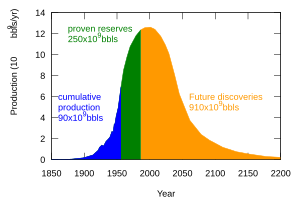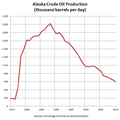Peak oil facts for kids
Peak oil is an idea about when we produce the most oil we ever will. Imagine a big oil well, an oil field, or even a whole country. At some point, it will pump out the most oil it possibly can in one day. After that, the amount of oil it produces will start to go down.
When less oil is produced, it becomes harder to find and costs more money. Many scientists and governments are thinking about what will happen when there isn't as much oil available for everyone to use.
Contents
What is Peak Oil?
The idea of peak oil means that oil production doesn't just keep going up forever. It reaches a highest point, like the top of a hill, and then it starts to decline. This happens because oil is a natural resource that takes millions of years to form. We are using it much faster than it can be made.
Who Came Up With This Idea?
A smart scientist named M.K. Hubbert first talked about this in the 1950s and 1960s. He noticed that if you graph how much oil is produced over time, it often looks like a bell-shaped curve. This curve is now called Hubbert's Curve.
Hubbert's Prediction for the United States
In 1956, Hubbert made a prediction for the United States. He said that the U.S. would reach its peak oil production in the early 1970s. And guess what? He was right! The United States did indeed reach its highest oil production point around that time. After that, U.S. oil production started to go down for many years.
When Will the World Reach Peak Oil?
It's a bit tricky to say exactly when the whole world will reach its peak oil production. Many scientists believe it might have already happened in the early 2000s or will happen before 2020. For example, in 2010, the International Energy Agency (IEA), which is a big group that studies energy, suggested that the world's peak oil might have been in 2006.
Thinking about peak oil helps us understand why it's important to find new ways to get energy. It also makes us think about using less oil and being more careful with our natural resources.
Images for kids
-
Proven oil reserves, 2013
-
Syncrude's Mildred Lake mine site and plant near Fort McMurray, Alberta
See also
 In Spanish: Teoría del pico de Hubbert para niños
In Spanish: Teoría del pico de Hubbert para niños



















